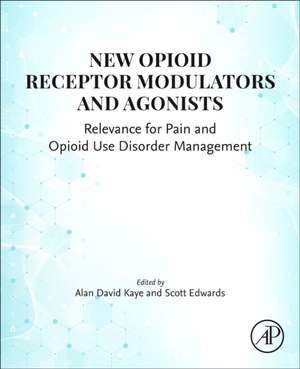New Opioid Receptor Modulators and Agonists: Relevance for Pain and Opioid Use Disorder Management
Editat de Alan David Kaye, Elyse C. Bradley, Scott Edwardsen Limba Engleză Paperback – sep 2025
It also explores pharmacogenomics, precision medicine, and various syndromes and comorbidities linked to opioid use. Lastly, it reviews novel synthetic opioids and the risks of misuse and overdose.
- Provides an in-depth look at opioid receptor system and novel aspects of opioid pharmacology<
- Discusses novel synthetic opioid clinical considerations
- Examines synthetic opioid misuse and pain management
Preț: 779.81 lei
Preț vechi: 856.94 lei
-9% Nou
Puncte Express: 1170
Preț estimativ în valută:
149.22€ • 162.59$ • 125.74£
149.22€ • 162.59$ • 125.74£
Carte nepublicată încă
Doresc să fiu notificat când acest titlu va fi disponibil:
Se trimite...
Preluare comenzi: 021 569.72.76
Specificații
ISBN-13: 9780443265044
ISBN-10: 0443265046
Pagini: 300
Dimensiuni: 191 x 235 mm
Editura: ELSEVIER SCIENCE
ISBN-10: 0443265046
Pagini: 300
Dimensiuni: 191 x 235 mm
Editura: ELSEVIER SCIENCE
Cuprins
The Opioid Receptor System and Novel Aspects of Opioid Pharmacology
1. Making Sense of the Complexities of Opioid Receptor Function: Evolving Appreciation of Opioid Receptor Classification and Basic Characteristics
2. Allostery at Opioid Receptors: Modulation with Small Molecule Ligands, Regulator of G-Protein Signaling (RGS) Protein Modulation of Opioid Receptor Signaling as a Potential Target for Pain Management
3. Opioid Agonist and Antagonist Pharmacology: Phenylpiperidines, Tramadol, Buprenoprhine, Methadone, and Codeine Derivatives Synthetic Opioid Clinical Considerations
4. Pharmacogenomics/Precision Medicine: Opioid-related Interactions and Metabolism Considerations
5. Opioid-associated Syndromes and Comorbidities
6. Opioid-induced Hyperalgesia
7. Drug Facts: Novel Synthetic Opioids Synthetic Opioid Misuse and Pain Management
8. Roots of the Opioid Crisis: Description of the Four Waves of the Opioid Epidemic
9. Opioids and Risk of Dependency: Neurobiology of Opioid Use Disorder
10. Opioids and Risk of Dependency: Responsibilities of Healthcare Workers, Manufacturers, and Pharmacists
11. CDC Guidelines for Chronic Pain in the Adult, Including Newer Guidelines Against Co-prescription with Benzodiazepines.
12. Commonly Prescribed Opioids and Adjuvants in Acute and Chronic Pain Management
13. Clinical Considerations of Commonly Prescribed Medications in Substance Abuse Management (e.g., buprenorphine (how is it prescribed); methadone (concerns over prolonged QT EKG prior to administration; urine drug screens
14. The Role of Naltrexone and Novel Preparations for Substance Abuse and Pain Management
15. Palliative Care for Cancer and Considerations for Opioid-mediated Suppression of Natural Killer Cells
16. Abuse Deterrent Formulations of Opioids and Opioid Vaccines
17. Opioid Detoxification Techniques
1. Making Sense of the Complexities of Opioid Receptor Function: Evolving Appreciation of Opioid Receptor Classification and Basic Characteristics
2. Allostery at Opioid Receptors: Modulation with Small Molecule Ligands, Regulator of G-Protein Signaling (RGS) Protein Modulation of Opioid Receptor Signaling as a Potential Target for Pain Management
3. Opioid Agonist and Antagonist Pharmacology: Phenylpiperidines, Tramadol, Buprenoprhine, Methadone, and Codeine Derivatives Synthetic Opioid Clinical Considerations
4. Pharmacogenomics/Precision Medicine: Opioid-related Interactions and Metabolism Considerations
5. Opioid-associated Syndromes and Comorbidities
6. Opioid-induced Hyperalgesia
7. Drug Facts: Novel Synthetic Opioids Synthetic Opioid Misuse and Pain Management
8. Roots of the Opioid Crisis: Description of the Four Waves of the Opioid Epidemic
9. Opioids and Risk of Dependency: Neurobiology of Opioid Use Disorder
10. Opioids and Risk of Dependency: Responsibilities of Healthcare Workers, Manufacturers, and Pharmacists
11. CDC Guidelines for Chronic Pain in the Adult, Including Newer Guidelines Against Co-prescription with Benzodiazepines.
12. Commonly Prescribed Opioids and Adjuvants in Acute and Chronic Pain Management
13. Clinical Considerations of Commonly Prescribed Medications in Substance Abuse Management (e.g., buprenorphine (how is it prescribed); methadone (concerns over prolonged QT EKG prior to administration; urine drug screens
14. The Role of Naltrexone and Novel Preparations for Substance Abuse and Pain Management
15. Palliative Care for Cancer and Considerations for Opioid-mediated Suppression of Natural Killer Cells
16. Abuse Deterrent Formulations of Opioids and Opioid Vaccines
17. Opioid Detoxification Techniques
